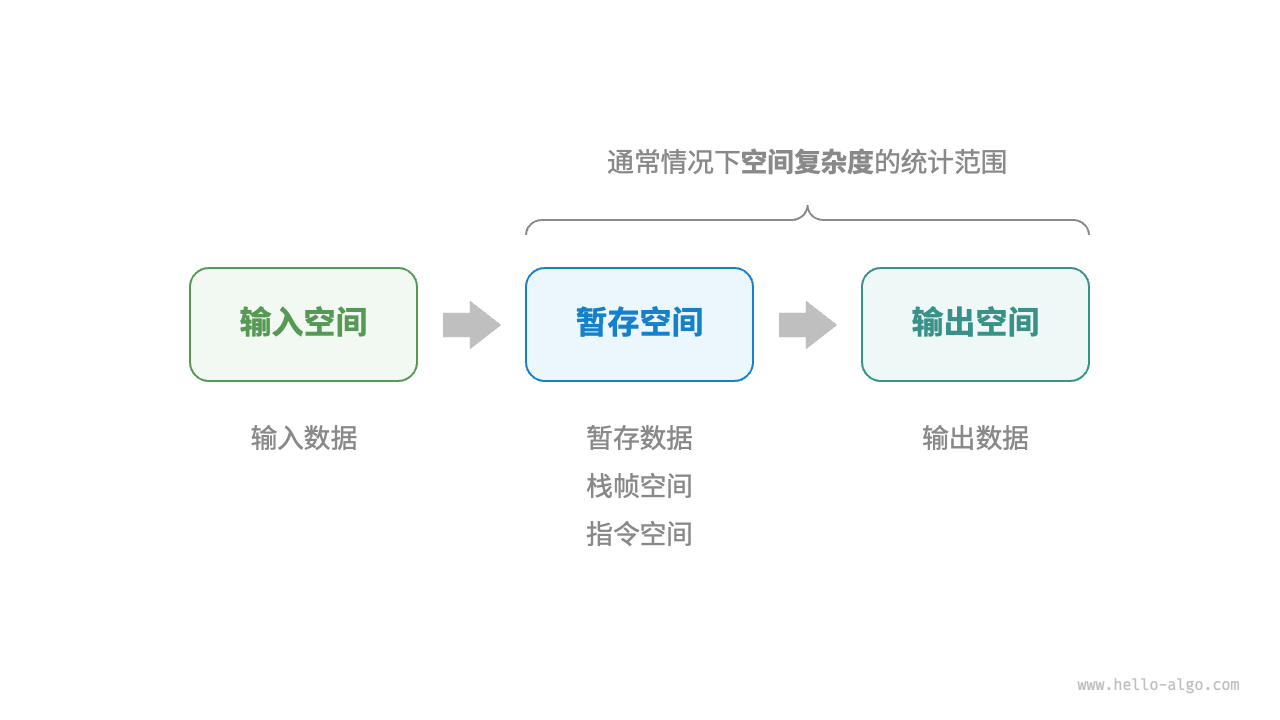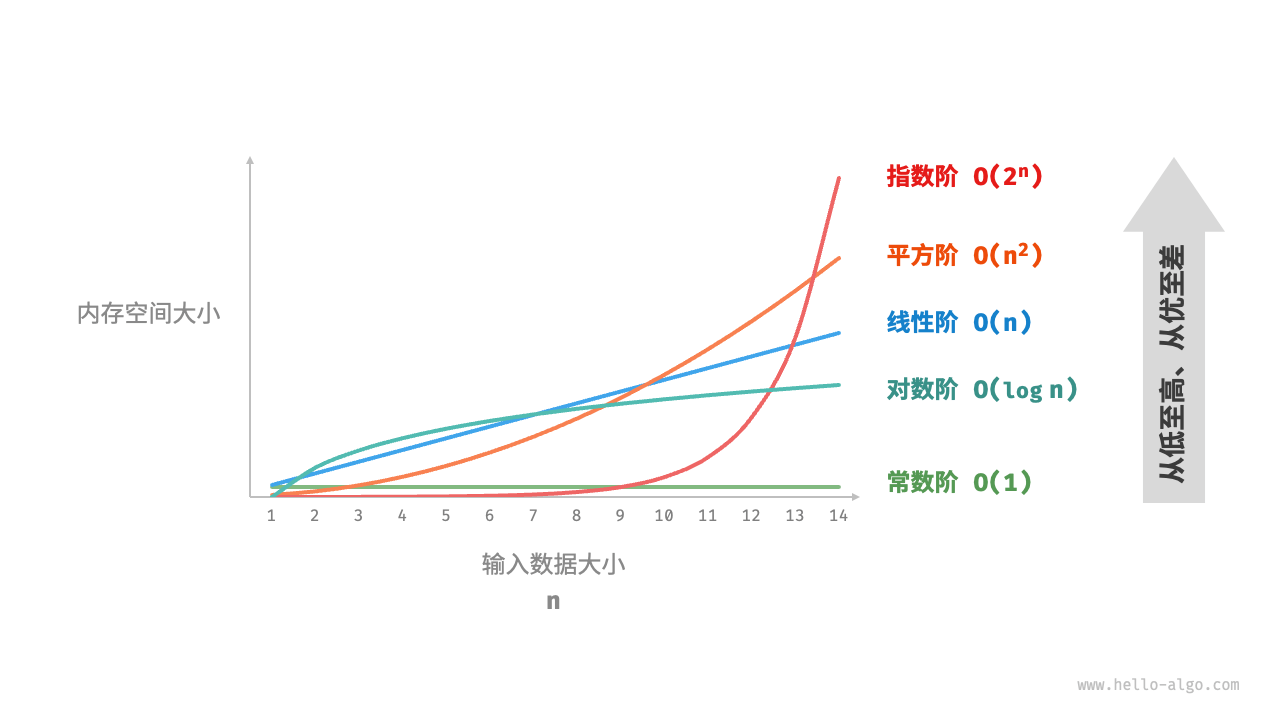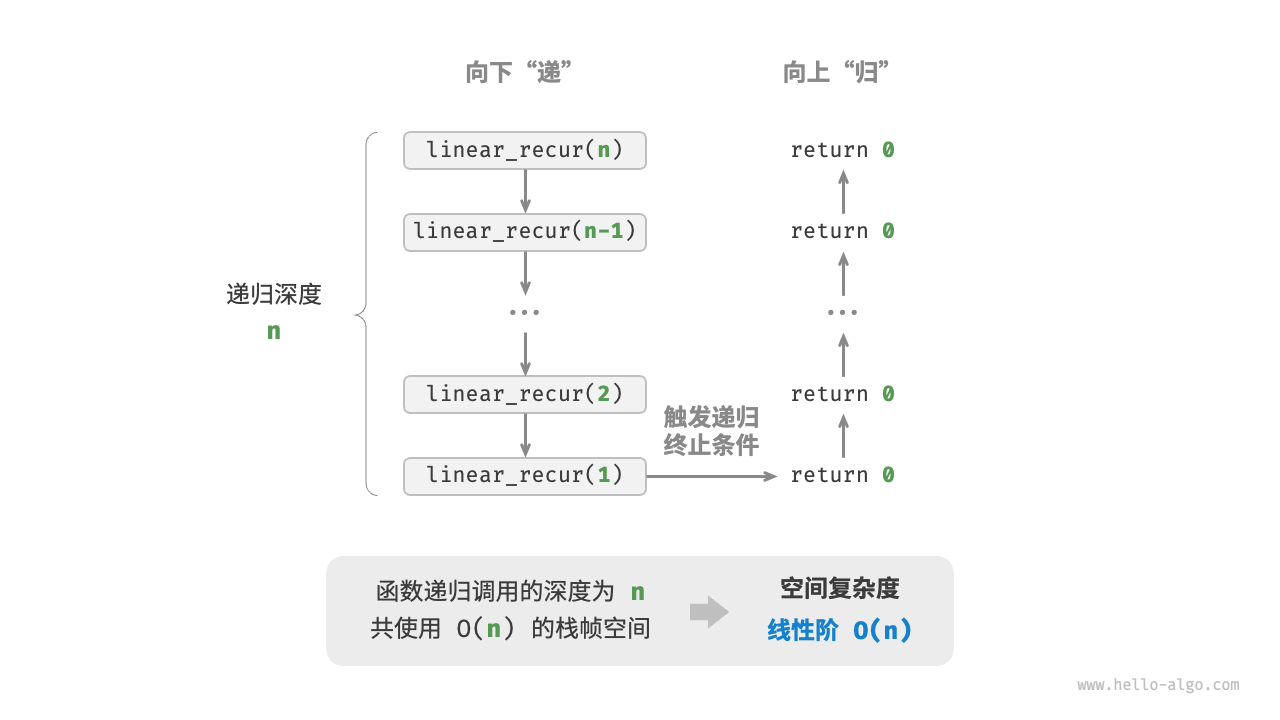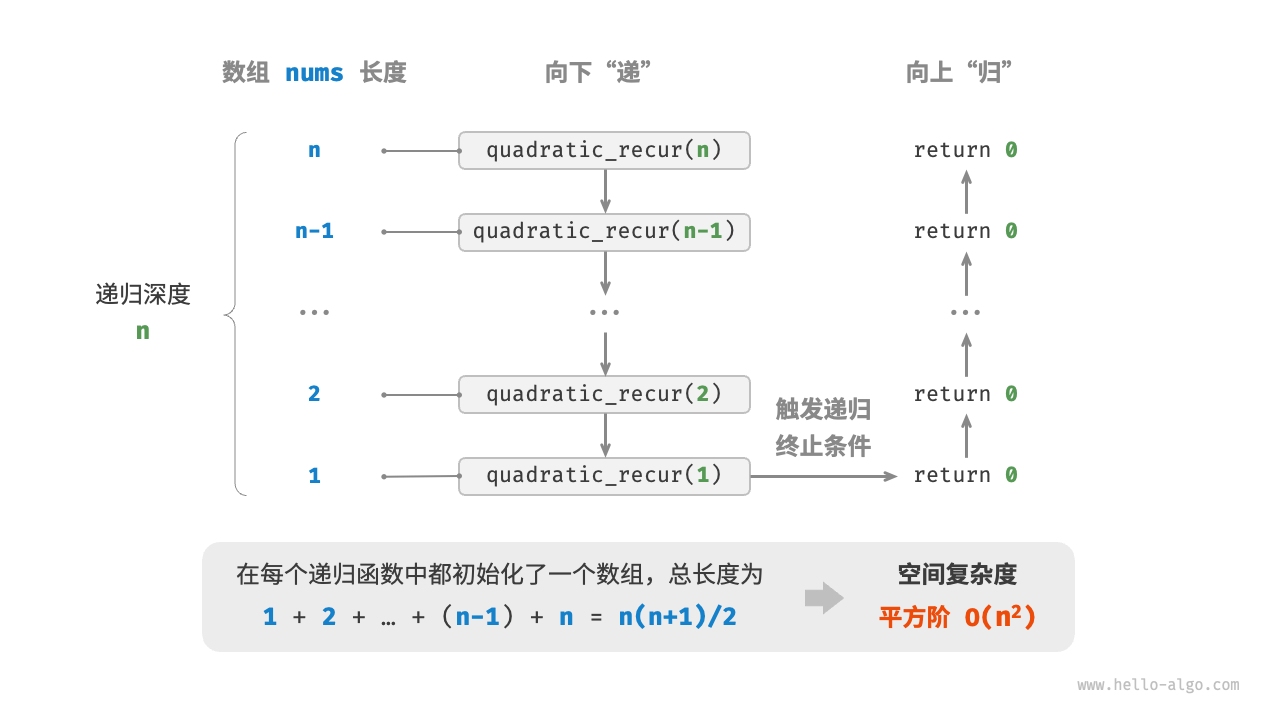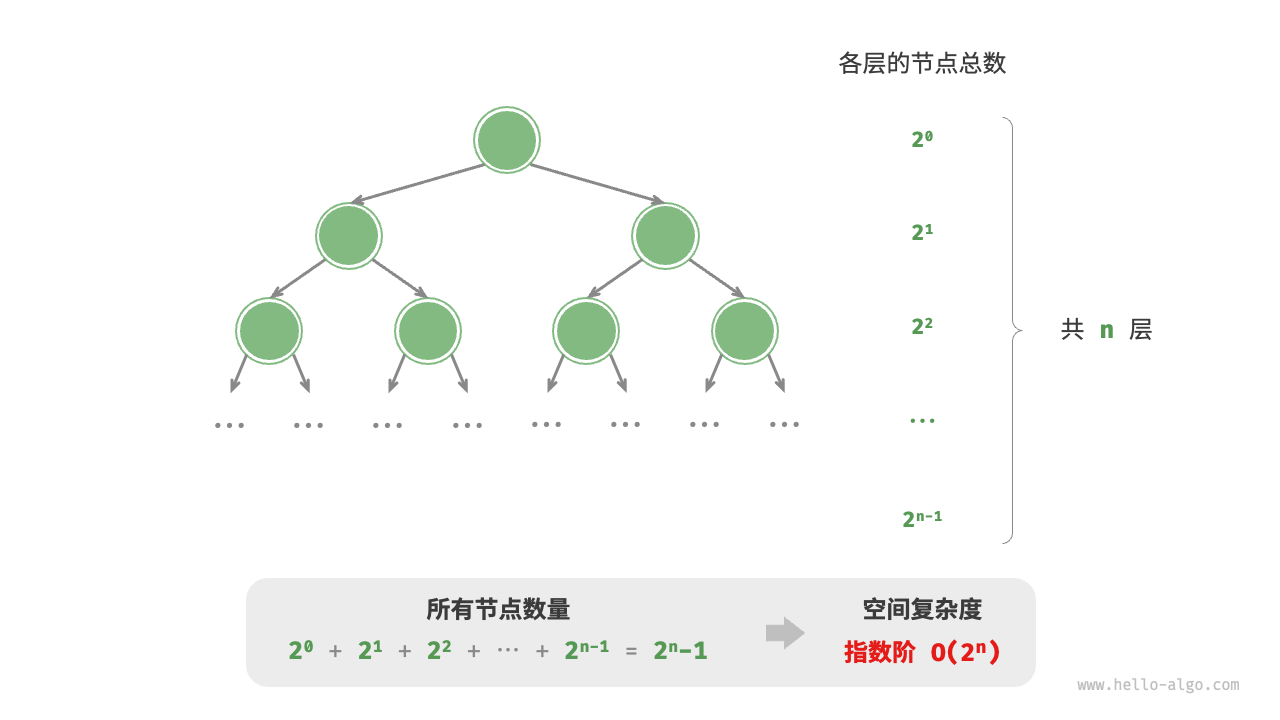2.4 空间复杂度¶
空间复杂度(space complexity)用于衡量算法占用内存空间随着数据量变大时的增长趋势。这个概念与时间复杂度非常类似,只需将“运行时间”替换为“占用内存空间”。
2.4.1 算法相关空间¶
算法在运行过程中使用的内存空间主要包括以下几种。
- 输入空间:用于存储算法的输入数据。
- 暂存空间:用于存储算法在运行过程中的变量、对象、函数上下文等数据。
- 输出空间:用于存储算法的输出数据。
一般情况下,空间复杂度的统计范围是“暂存空间”加上“输出空间”。
暂存空间可以进一步划分为三个部分。
- 暂存数据:用于保存算法运行过程中的各种常量、变量、对象等。
- 栈帧空间:用于保存调用函数的上下文数据。系统在每次调用函数时都会在栈顶部创建一个栈帧,函数返回后,栈帧空间会被释放。
- 指令空间:用于保存编译后的程序指令,在实际统计中通常忽略不计。
在分析一段程序的空间复杂度时,我们通常统计暂存数据、栈帧空间和输出数据三部分,如图 2-15 所示。
图 2-15 算法使用的相关空间
相关代码如下:
class Node:
"""类"""
def __init__(self, x: int):
self.val: int = x # 节点值
self.next: Node | None = None # 指向下一节点的引用
def function() -> int:
"""函数"""
# 执行某些操作...
return 0
def algorithm(n) -> int: # 输入数据
A = 0 # 暂存数据(常量,一般用大写字母表示)
b = 0 # 暂存数据(变量)
node = Node(0) # 暂存数据(对象)
c = function() # 栈帧空间(调用函数)
return A + b + c # 输出数据
/* 结构体 */
struct Node {
int val;
Node *next;
Node(int x) : val(x), next(nullptr) {}
};
/* 函数 */
int func() {
// 执行某些操作...
return 0;
}
int algorithm(int n) { // 输入数据
const int a = 0; // 暂存数据(常量)
int b = 0; // 暂存数据(变量)
Node* node = new Node(0); // 暂存数据(对象)
int c = func(); // 栈帧空间(调用函数)
return a + b + c; // 输出数据
}
/* 类 */
class Node {
int val;
Node next;
Node(int x) { val = x; }
}
/* 函数 */
int function() {
// 执行某些操作...
return 0;
}
int algorithm(int n) { // 输入数据
final int a = 0; // 暂存数据(常量)
int b = 0; // 暂存数据(变量)
Node node = new Node(0); // 暂存数据(对象)
int c = function(); // 栈帧空间(调用函数)
return a + b + c; // 输出数据
}
/* 结构体 */
type node struct {
val int
next *node
}
/* 创建 node 结构体 */
func newNode(val int) *node {
return &node{val: val}
}
/* 函数 */
func function() int {
// 执行某些操作...
return 0
}
func algorithm(n int) int { // 输入数据
const a = 0 // 暂存数据(常量)
b := 0 // 暂存数据(变量)
newNode(0) // 暂存数据(对象)
c := function() // 栈帧空间(调用函数)
return a + b + c // 输出数据
}
/* 类 */
class Node {
var val: Int
var next: Node?
init(x: Int) {
val = x
}
}
/* 函数 */
func function() -> Int {
// 执行某些操作...
return 0
}
func algorithm(n: Int) -> Int { // 输入数据
let a = 0 // 暂存数据(常量)
var b = 0 // 暂存数据(变量)
let node = Node(x: 0) // 暂存数据(对象)
let c = function() // 栈帧空间(调用函数)
return a + b + c // 输出数据
}
/* 类 */
class Node {
val;
next;
constructor(val) {
this.val = val === undefined ? 0 : val; // 节点值
this.next = null; // 指向下一节点的引用
}
}
/* 函数 */
function constFunc() {
// 执行某些操作
return 0;
}
function algorithm(n) { // 输入数据
const a = 0; // 暂存数据(常量)
let b = 0; // 暂存数据(变量)
const node = new Node(0); // 暂存数据(对象)
const c = constFunc(); // 栈帧空间(调用函数)
return a + b + c; // 输出数据
}
/* 类 */
class Node {
val: number;
next: Node | null;
constructor(val?: number) {
this.val = val === undefined ? 0 : val; // 节点值
this.next = null; // 指向下一节点的引用
}
}
/* 函数 */
function constFunc(): number {
// 执行某些操作
return 0;
}
function algorithm(n: number): number { // 输入数据
const a = 0; // 暂存数据(常量)
let b = 0; // 暂存数据(变量)
const node = new Node(0); // 暂存数据(对象)
const c = constFunc(); // 栈帧空间(调用函数)
return a + b + c; // 输出数据
}
/* 类 */
class Node {
int val;
Node next;
Node(this.val, [this.next]);
}
/* 函数 */
int function() {
// 执行某些操作...
return 0;
}
int algorithm(int n) { // 输入数据
const int a = 0; // 暂存数据(常量)
int b = 0; // 暂存数据(变量)
Node node = Node(0); // 暂存数据(对象)
int c = function(); // 栈帧空间(调用函数)
return a + b + c; // 输出数据
}
use std::rc::Rc;
use std::cell::RefCell;
/* 结构体 */
struct Node {
val: i32,
next: Option<Rc<RefCell<Node>>>,
}
/* 创建 Node 结构体 */
impl Node {
fn new(val: i32) -> Self {
Self { val: val, next: None }
}
}
/* 函数 */
fn function() -> i32 {
// 执行某些操作...
return 0;
}
fn algorithm(n: i32) -> i32 { // 输入数据
const a: i32 = 0; // 暂存数据(常量)
let mut b = 0; // 暂存数据(变量)
let node = Node::new(0); // 暂存数据(对象)
let c = function(); // 栈帧空间(调用函数)
return a + b + c; // 输出数据
}
### 类 ###
class Node
attr_accessor :val # 节点值
attr_accessor :next # 指向下一节点的引用
def initialize(x)
@val = x
end
end
### 函数 ###
def function
# 执行某些操作...
0
end
### 算法 ###
def algorithm(n) # 输入数据
a = 0 # 暂存数据(常量)
b = 0 # 暂存数据(变量)
node = Node.new(0) # 暂存数据(对象)
c = function # 栈帧空间(调用函数)
a + b + c # 输出数据
end
2.4.2 推算方法¶
空间复杂度的推算方法与时间复杂度大致相同,只需将统计对象从“操作数量”转为“使用空间大小”。
而与时间复杂度不同的是,我们通常只关注最差空间复杂度。这是因为内存空间是一项硬性要求,我们必须确保在所有输入数据下都有足够的内存空间预留。
观察以下代码,最差空间复杂度中的“最差”有两层含义。
- 以最差输入数据为准:当 \(n < 10\) 时,空间复杂度为 \(O(1)\) ;但当 \(n > 10\) 时,初始化的数组
nums占用 \(O(n)\) 空间,因此最差空间复杂度为 \(O(n)\) 。 - 以算法运行中的峰值内存为准:例如,程序在执行最后一行之前,占用 \(O(1)\) 空间;当初始化数组
nums时,程序占用 \(O(n)\) 空间,因此最差空间复杂度为 \(O(n)\) 。
在递归函数中,需要注意统计栈帧空间。观察以下代码:
函数 loop() 和 recur() 的时间复杂度都为 \(O(n)\) ,但空间复杂度不同。
- 函数
loop()在循环中调用了 \(n\) 次function(),每轮中的function()都返回并释放了栈帧空间,因此空间复杂度仍为 \(O(1)\) 。 - 递归函数
recur()在运行过程中会同时存在 \(n\) 个未返回的recur(),从而占用 \(O(n)\) 的栈帧空间。
2.4.3 常见类型¶
设输入数据大小为 \(n\) ,图 2-16 展示了常见的空间复杂度类型(从低到高排列)。
图 2-16 常见的空间复杂度类型
1. 常数阶 \(O(1)\)¶
常数阶常见于数量与输入数据大小 \(n\) 无关的常量、变量、对象。
需要注意的是,在循环中初始化变量或调用函数而占用的内存,在进入下一循环后就会被释放,因此不会累积占用空间,空间复杂度仍为 \(O(1)\) :
/* 函数 */
int func() {
// 执行某些操作
return 0;
}
/* 常数阶 */
void constant(int n) {
// 常量、变量、对象占用 O(1) 空间
const int a = 0;
int b = 0;
vector<int> nums(10000);
ListNode node(0);
// 循环中的变量占用 O(1) 空间
for (int i = 0; i < n; i++) {
int c = 0;
}
// 循环中的函数占用 O(1) 空间
for (int i = 0; i < n; i++) {
func();
}
}
/* 函数 */
int function() {
// 执行某些操作
return 0;
}
/* 常数阶 */
void constant(int n) {
// 常量、变量、对象占用 O(1) 空间
final int a = 0;
int b = 0;
int[] nums = new int[10000];
ListNode node = new ListNode(0);
// 循环中的变量占用 O(1) 空间
for (int i = 0; i < n; i++) {
int c = 0;
}
// 循环中的函数占用 O(1) 空间
for (int i = 0; i < n; i++) {
function();
}
}
/* 函数 */
int Function() {
// 执行某些操作
return 0;
}
/* 常数阶 */
void Constant(int n) {
// 常量、变量、对象占用 O(1) 空间
int a = 0;
int b = 0;
int[] nums = new int[10000];
ListNode node = new(0);
// 循环中的变量占用 O(1) 空间
for (int i = 0; i < n; i++) {
int c = 0;
}
// 循环中的函数占用 O(1) 空间
for (int i = 0; i < n; i++) {
Function();
}
}
/* 函数 */
func function() int {
// 执行某些操作...
return 0
}
/* 常数阶 */
func spaceConstant(n int) {
// 常量、变量、对象占用 O(1) 空间
const a = 0
b := 0
nums := make([]int, 10000)
node := newNode(0)
// 循环中的变量占用 O(1) 空间
var c int
for i := 0; i < n; i++ {
c = 0
}
// 循环中的函数占用 O(1) 空间
for i := 0; i < n; i++ {
function()
}
b += 0
c += 0
nums[0] = 0
node.val = 0
}
/* 函数 */
@discardableResult
func function() -> Int {
// 执行某些操作
return 0
}
/* 常数阶 */
func constant(n: Int) {
// 常量、变量、对象占用 O(1) 空间
let a = 0
var b = 0
let nums = Array(repeating: 0, count: 10000)
let node = ListNode(x: 0)
// 循环中的变量占用 O(1) 空间
for _ in 0 ..< n {
let c = 0
}
// 循环中的函数占用 O(1) 空间
for _ in 0 ..< n {
function()
}
}
/* 函数 */
function constFunc() {
// 执行某些操作
return 0;
}
/* 常数阶 */
function constant(n) {
// 常量、变量、对象占用 O(1) 空间
const a = 0;
const b = 0;
const nums = new Array(10000);
const node = new ListNode(0);
// 循环中的变量占用 O(1) 空间
for (let i = 0; i < n; i++) {
const c = 0;
}
// 循环中的函数占用 O(1) 空间
for (let i = 0; i < n; i++) {
constFunc();
}
}
/* 函数 */
function constFunc(): number {
// 执行某些操作
return 0;
}
/* 常数阶 */
function constant(n: number): void {
// 常量、变量、对象占用 O(1) 空间
const a = 0;
const b = 0;
const nums = new Array(10000);
const node = new ListNode(0);
// 循环中的变量占用 O(1) 空间
for (let i = 0; i < n; i++) {
const c = 0;
}
// 循环中的函数占用 O(1) 空间
for (let i = 0; i < n; i++) {
constFunc();
}
}
/* 函数 */
int function() {
// 执行某些操作
return 0;
}
/* 常数阶 */
void constant(int n) {
// 常量、变量、对象占用 O(1) 空间
final int a = 0;
int b = 0;
List<int> nums = List.filled(10000, 0);
ListNode node = ListNode(0);
// 循环中的变量占用 O(1) 空间
for (var i = 0; i < n; i++) {
int c = 0;
}
// 循环中的函数占用 O(1) 空间
for (var i = 0; i < n; i++) {
function();
}
}
/* 函数 */
fn function() -> i32 {
// 执行某些操作
return 0;
}
/* 常数阶 */
#[allow(unused)]
fn constant(n: i32) {
// 常量、变量、对象占用 O(1) 空间
const A: i32 = 0;
let b = 0;
let nums = vec![0; 10000];
let node = ListNode::new(0);
// 循环中的变量占用 O(1) 空间
for i in 0..n {
let c = 0;
}
// 循环中的函数占用 O(1) 空间
for i in 0..n {
function();
}
}
/* 函数 */
int func() {
// 执行某些操作
return 0;
}
/* 常数阶 */
void constant(int n) {
// 常量、变量、对象占用 O(1) 空间
const int a = 0;
int b = 0;
int nums[1000];
ListNode *node = newListNode(0);
free(node);
// 循环中的变量占用 O(1) 空间
for (int i = 0; i < n; i++) {
int c = 0;
}
// 循环中的函数占用 O(1) 空间
for (int i = 0; i < n; i++) {
func();
}
}
/* 函数 */
fun function(): Int {
// 执行某些操作
return 0
}
/* 常数阶 */
fun constant(n: Int) {
// 常量、变量、对象占用 O(1) 空间
val a = 0
var b = 0
val nums = Array(10000) { 0 }
val node = ListNode(0)
// 循环中的变量占用 O(1) 空间
for (i in 0..<n) {
val c = 0
}
// 循环中的函数占用 O(1) 空间
for (i in 0..<n) {
function()
}
}
// 函数
fn function() i32 {
// 执行某些操作
return 0;
}
// 常数阶
fn constant(n: i32) void {
// 常量、变量、对象占用 O(1) 空间
const a: i32 = 0;
var b: i32 = 0;
var nums = [_]i32{0}**10000;
var node = inc.ListNode(i32){.val = 0};
var i: i32 = 0;
// 循环中的变量占用 O(1) 空间
while (i < n) : (i += 1) {
var c: i32 = 0;
_ = c;
}
// 循环中的函数占用 O(1) 空间
i = 0;
while (i < n) : (i += 1) {
_ = function();
}
_ = a;
_ = b;
_ = nums;
_ = node;
}
可视化运行
2. 线性阶 \(O(n)\)¶
线性阶常见于元素数量与 \(n\) 成正比的数组、链表、栈、队列等:
/* 线性阶 */
void linear(int n) {
// 长度为 n 的数组占用 O(n) 空间
vector<int> nums(n);
// 长度为 n 的列表占用 O(n) 空间
vector<ListNode> nodes;
for (int i = 0; i < n; i++) {
nodes.push_back(ListNode(i));
}
// 长度为 n 的哈希表占用 O(n) 空间
unordered_map<int, string> map;
for (int i = 0; i < n; i++) {
map[i] = to_string(i);
}
}
/* 线性阶 */
void linear(int n) {
// 长度为 n 的数组占用 O(n) 空间
int[] nums = new int[n];
// 长度为 n 的列表占用 O(n) 空间
List<ListNode> nodes = new ArrayList<>();
for (int i = 0; i < n; i++) {
nodes.add(new ListNode(i));
}
// 长度为 n 的哈希表占用 O(n) 空间
Map<Integer, String> map = new HashMap<>();
for (int i = 0; i < n; i++) {
map.put(i, String.valueOf(i));
}
}
/* 线性阶 */
void Linear(int n) {
// 长度为 n 的数组占用 O(n) 空间
int[] nums = new int[n];
// 长度为 n 的列表占用 O(n) 空间
List<ListNode> nodes = [];
for (int i = 0; i < n; i++) {
nodes.Add(new ListNode(i));
}
// 长度为 n 的哈希表占用 O(n) 空间
Dictionary<int, string> map = [];
for (int i = 0; i < n; i++) {
map.Add(i, i.ToString());
}
}
/* 线性阶 */
func spaceLinear(n int) {
// 长度为 n 的数组占用 O(n) 空间
_ = make([]int, n)
// 长度为 n 的列表占用 O(n) 空间
var nodes []*node
for i := 0; i < n; i++ {
nodes = append(nodes, newNode(i))
}
// 长度为 n 的哈希表占用 O(n) 空间
m := make(map[int]string, n)
for i := 0; i < n; i++ {
m[i] = strconv.Itoa(i)
}
}
/* 线性阶 */
function linear(n) {
// 长度为 n 的数组占用 O(n) 空间
const nums = new Array(n);
// 长度为 n 的列表占用 O(n) 空间
const nodes = [];
for (let i = 0; i < n; i++) {
nodes.push(new ListNode(i));
}
// 长度为 n 的哈希表占用 O(n) 空间
const map = new Map();
for (let i = 0; i < n; i++) {
map.set(i, i.toString());
}
}
/* 线性阶 */
function linear(n: number): void {
// 长度为 n 的数组占用 O(n) 空间
const nums = new Array(n);
// 长度为 n 的列表占用 O(n) 空间
const nodes: ListNode[] = [];
for (let i = 0; i < n; i++) {
nodes.push(new ListNode(i));
}
// 长度为 n 的哈希表占用 O(n) 空间
const map = new Map();
for (let i = 0; i < n; i++) {
map.set(i, i.toString());
}
}
/* 线性阶 */
void linear(int n) {
// 长度为 n 的数组占用 O(n) 空间
List<int> nums = List.filled(n, 0);
// 长度为 n 的列表占用 O(n) 空间
List<ListNode> nodes = [];
for (var i = 0; i < n; i++) {
nodes.add(ListNode(i));
}
// 长度为 n 的哈希表占用 O(n) 空间
Map<int, String> map = HashMap();
for (var i = 0; i < n; i++) {
map.putIfAbsent(i, () => i.toString());
}
}
/* 线性阶 */
#[allow(unused)]
fn linear(n: i32) {
// 长度为 n 的数组占用 O(n) 空间
let mut nums = vec![0; n as usize];
// 长度为 n 的列表占用 O(n) 空间
let mut nodes = Vec::new();
for i in 0..n {
nodes.push(ListNode::new(i))
}
// 长度为 n 的哈希表占用 O(n) 空间
let mut map = HashMap::new();
for i in 0..n {
map.insert(i, i.to_string());
}
}
/* 哈希表 */
typedef struct {
int key;
int val;
UT_hash_handle hh; // 基于 uthash.h 实现
} HashTable;
/* 线性阶 */
void linear(int n) {
// 长度为 n 的数组占用 O(n) 空间
int *nums = malloc(sizeof(int) * n);
free(nums);
// 长度为 n 的列表占用 O(n) 空间
ListNode **nodes = malloc(sizeof(ListNode *) * n);
for (int i = 0; i < n; i++) {
nodes[i] = newListNode(i);
}
// 内存释放
for (int i = 0; i < n; i++) {
free(nodes[i]);
}
free(nodes);
// 长度为 n 的哈希表占用 O(n) 空间
HashTable *h = NULL;
for (int i = 0; i < n; i++) {
HashTable *tmp = malloc(sizeof(HashTable));
tmp->key = i;
tmp->val = i;
HASH_ADD_INT(h, key, tmp);
}
// 内存释放
HashTable *curr, *tmp;
HASH_ITER(hh, h, curr, tmp) {
HASH_DEL(h, curr);
free(curr);
}
}
/* 线性阶 */
fun linear(n: Int) {
// 长度为 n 的数组占用 O(n) 空间
val nums = Array(n) { 0 }
// 长度为 n 的列表占用 O(n) 空间
val nodes = mutableListOf<ListNode>()
for (i in 0..<n) {
nodes.add(ListNode(i))
}
// 长度为 n 的哈希表占用 O(n) 空间
val map = mutableMapOf<Int, String>()
for (i in 0..<n) {
map[i] = i.toString()
}
}
// 线性阶
fn linear(comptime n: i32) !void {
// 长度为 n 的数组占用 O(n) 空间
var nums = [_]i32{0}**n;
// 长度为 n 的列表占用 O(n) 空间
var nodes = std.ArrayList(i32).init(std.heap.page_allocator);
defer nodes.deinit();
var i: i32 = 0;
while (i < n) : (i += 1) {
try nodes.append(i);
}
// 长度为 n 的哈希表占用 O(n) 空间
var map = std.AutoArrayHashMap(i32, []const u8).init(std.heap.page_allocator);
defer map.deinit();
var j: i32 = 0;
while (j < n) : (j += 1) {
const string = try std.fmt.allocPrint(std.heap.page_allocator, "{d}", .{j});
defer std.heap.page_allocator.free(string);
try map.put(i, string);
}
_ = nums;
}
可视化运行
如图 2-17 所示,此函数的递归深度为 \(n\) ,即同时存在 \(n\) 个未返回的 linear_recur() 函数,使用 \(O(n)\) 大小的栈帧空间:
可视化运行
图 2-17 递归函数产生的线性阶空间复杂度
3. 平方阶 \(O(n^2)\)¶
平方阶常见于矩阵和图,元素数量与 \(n\) 成平方关系:
/* 平方阶 */
void quadratic(int n) {
// 矩阵占用 O(n^2) 空间
int[][] numMatrix = new int[n][n];
// 二维列表占用 O(n^2) 空间
List<List<Integer>> numList = new ArrayList<>();
for (int i = 0; i < n; i++) {
List<Integer> tmp = new ArrayList<>();
for (int j = 0; j < n; j++) {
tmp.add(0);
}
numList.add(tmp);
}
}
/* 平方阶 */
function quadratic(n: number): void {
// 矩阵占用 O(n^2) 空间
const numMatrix = Array(n)
.fill(null)
.map(() => Array(n).fill(null));
// 二维列表占用 O(n^2) 空间
const numList = [];
for (let i = 0; i < n; i++) {
const tmp = [];
for (let j = 0; j < n; j++) {
tmp.push(0);
}
numList.push(tmp);
}
}
/* 平方阶 */
void quadratic(int n) {
// 矩阵占用 O(n^2) 空间
List<List<int>> numMatrix = List.generate(n, (_) => List.filled(n, 0));
// 二维列表占用 O(n^2) 空间
List<List<int>> numList = [];
for (var i = 0; i < n; i++) {
List<int> tmp = [];
for (int j = 0; j < n; j++) {
tmp.add(0);
}
numList.add(tmp);
}
}
/* 平方阶 */
void quadratic(int n) {
// 二维列表占用 O(n^2) 空间
int **numMatrix = malloc(sizeof(int *) * n);
for (int i = 0; i < n; i++) {
int *tmp = malloc(sizeof(int) * n);
for (int j = 0; j < n; j++) {
tmp[j] = 0;
}
numMatrix[i] = tmp;
}
// 内存释放
for (int i = 0; i < n; i++) {
free(numMatrix[i]);
}
free(numMatrix);
}
// 平方阶
fn quadratic(n: i32) !void {
// 二维列表占用 O(n^2) 空间
var nodes = std.ArrayList(std.ArrayList(i32)).init(std.heap.page_allocator);
defer nodes.deinit();
var i: i32 = 0;
while (i < n) : (i += 1) {
var tmp = std.ArrayList(i32).init(std.heap.page_allocator);
defer tmp.deinit();
var j: i32 = 0;
while (j < n) : (j += 1) {
try tmp.append(0);
}
try nodes.append(tmp);
}
}
可视化运行
如图 2-18 所示,该函数的递归深度为 \(n\) ,在每个递归函数中都初始化了一个数组,长度分别为 \(n\)、\(n-1\)、\(\dots\)、\(2\)、\(1\) ,平均长度为 \(n / 2\) ,因此总体占用 \(O(n^2)\) 空间:
可视化运行
图 2-18 递归函数产生的平方阶空间复杂度
4. 指数阶 \(O(2^n)\)¶
指数阶常见于二叉树。观察图 2-19 ,层数为 \(n\) 的“满二叉树”的节点数量为 \(2^n - 1\) ,占用 \(O(2^n)\) 空间:
// 指数阶(建立满二叉树)
fn buildTree(mem_allocator: std.mem.Allocator, n: i32) !?*inc.TreeNode(i32) {
if (n == 0) return null;
const root = try mem_allocator.create(inc.TreeNode(i32));
root.init(0);
root.left = try buildTree(mem_allocator, n - 1);
root.right = try buildTree(mem_allocator, n - 1);
return root;
}
可视化运行
图 2-19 满二叉树产生的指数阶空间复杂度
5. 对数阶 \(O(\log n)\)¶
对数阶常见于分治算法。例如归并排序,输入长度为 \(n\) 的数组,每轮递归将数组从中点处划分为两半,形成高度为 \(\log n\) 的递归树,使用 \(O(\log n)\) 栈帧空间。
再例如将数字转化为字符串,输入一个正整数 \(n\) ,它的位数为 \(\lfloor \log_{10} n \rfloor + 1\) ,即对应字符串长度为 \(\lfloor \log_{10} n \rfloor + 1\) ,因此空间复杂度为 \(O(\log_{10} n + 1) = O(\log n)\) 。
2.4.4 权衡时间与空间¶
理想情况下,我们希望算法的时间复杂度和空间复杂度都能达到最优。然而在实际情况中,同时优化时间复杂度和空间复杂度通常非常困难。
降低时间复杂度通常需要以提升空间复杂度为代价,反之亦然。我们将牺牲内存空间来提升算法运行速度的思路称为“以空间换时间”;反之,则称为“以时间换空间”。
选择哪种思路取决于我们更看重哪个方面。在大多数情况下,时间比空间更宝贵,因此“以空间换时间”通常是更常用的策略。当然,在数据量很大的情况下,控制空间复杂度也非常重要。
